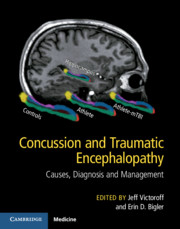Book contents
- Concussion and Traumatic Encephalopathy
- Concussion and Traumatic Encephalopathy
- Copyright page
- Dedication
- Contents
- Guiding Apophthegm
- List of Contributors
- Preface
- Acknowledgments
- Introduction
- Part I What Is a Concussion?
- 1 What Is a Concussive Brain Injury?
- 2 Epidemiology of Concussive Brain Injury
- 3 The Pathophysiology of Concussive Brain Injury
- 4 What Happens to Concussed Animals?
- 5 What Happens to Concussed Humans?
- 6 Neuroimaging Biomarkers for the Neuropsychological Investigation of Concussive Brain Injury (CBI) Outcome
- Part II Outcomes after Concussion
- Part III Diagnosis and Management of Concussion
- Index
- References
2 - Epidemiology of Concussive Brain Injury
from Part I - What Is a Concussion?
Published online by Cambridge University Press: 22 February 2019
- Concussion and Traumatic Encephalopathy
- Concussion and Traumatic Encephalopathy
- Copyright page
- Dedication
- Contents
- Guiding Apophthegm
- List of Contributors
- Preface
- Acknowledgments
- Introduction
- Part I What Is a Concussion?
- 1 What Is a Concussive Brain Injury?
- 2 Epidemiology of Concussive Brain Injury
- 3 The Pathophysiology of Concussive Brain Injury
- 4 What Happens to Concussed Animals?
- 5 What Happens to Concussed Humans?
- 6 Neuroimaging Biomarkers for the Neuropsychological Investigation of Concussive Brain Injury (CBI) Outcome
- Part II Outcomes after Concussion
- Part III Diagnosis and Management of Concussion
- Index
- References
Summary
- Type
- Chapter
- Information
- Concussion and Traumatic EncephalopathyCauses, Diagnosis and Management, pp. 93 - 137Publisher: Cambridge University PressPrint publication year: 2019

